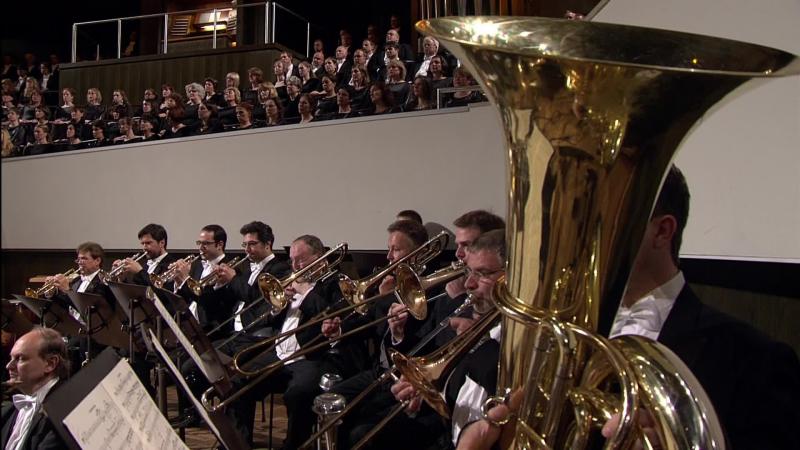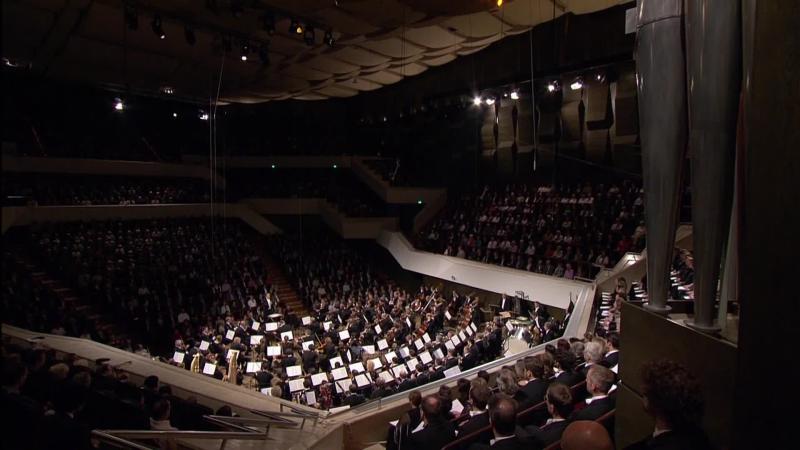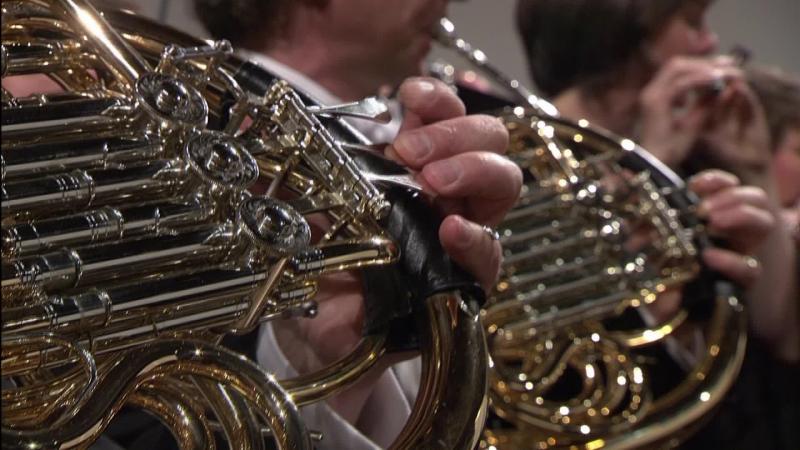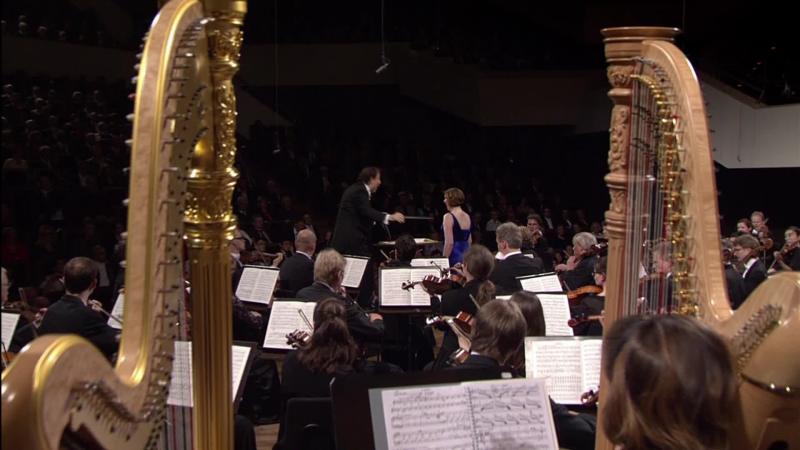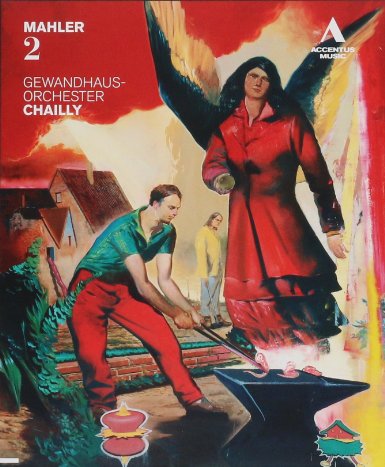
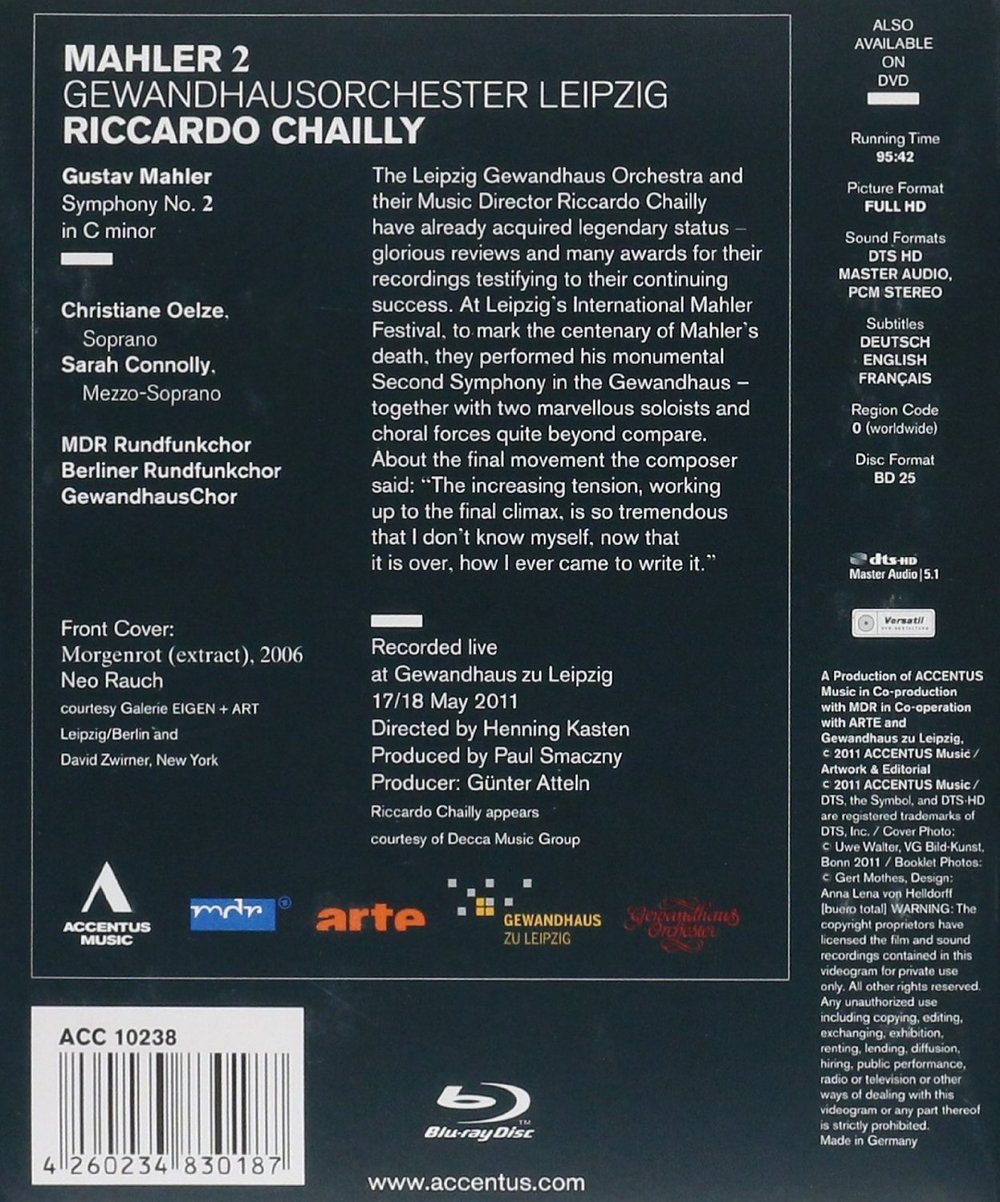
Mahler Symphony No. 2 "Resurrection”. Riccardo Chailly conducts the Gewandhausorchester Leipzig in 2011 as well as the MDR Rundfunkchor, the Berliner Rundfunkchor, and the GewandhousChor (Chorus Masters Howard Arman, Simon Halsey, and Gregor Meyer). Soloists are soprano Christiane Oelze and mezzo-soprano Sarah Connolly. Directed for TV by Henning Kasten; produced by Paul Smaczny. Released 2011, disc has 5.1 dts-HD Master Audio sound. Grade: C+
It's been several years since I last discussed DVDitis in detail. DVDitis is a disease that mostly afflicts recordings of symphony concerts that were intended to be published as DVDs and which are also published in Blu-ray. Because of low video resolution, DVD recordings can't provide good shots of an entire symphony orchestra or long shots of multiple sections of the orchestra. To cope with this limitation, the practice developed of shooting many short clips of the conductor alternating with many short clips of single musicians or small groups of musicians. This style of recording reminds me of the Road Runner cartoons.
But when you shoot an symphony orchestra with HD cameras, you can get decent long-range shots. So a symphony HDVD (Blu-ray disc) can be displayed in a more civilized and relaxed way that gets much closer than a DVD to the live experience a concertgoer has in the music hall. Find out more about this in our special article about the good symphony video in HDVD.
When a DVD is made of a symphony concert, you do the best you can with the modest resolution you have. If you take that recording and publish it on a Blu-ray disc, the consumer should get a nicer video picture and often also better sound. But it's still the Road Runner race. A good HDVD of a symphony has to have different and better video content from the DVD to meet our standards. If the HDVD has the same video content as the DVD, I diagnose DVDitis.
Today our sick patient is an Accentus Music Mahler Symphony No. 2 performed and published in 2011. It's been patiently waiting in my infirmary for several years to be examined. As any careful doctor would, I order a panel of tests. But before we read the report, let's discuss some of the things we are testing for.
The single most important hallmark of a good symphony HDVD is the presence of many whole-orchestra ("WO") shots. And the first duty of the videographer is to give us at home an opening WO shot to show us how the orchestra is organized and where all the sections are. After all, a single WO view is the only "shot" a live concertgoer gets to enjoy.
The first screenshot below is one of about 10 views that are the closest thing we get in subject video to a WO shot. We generously call this a WO view even though quite a few musicians are omitted on the flanks. Still, it shows the most of the orchestra and the chorus. But, alas, the camera is placed so low that you still can't see how the orchestra is organized:
Also, Kasten gives us about 6 shots like the one shown next below, which is also the first thing we see at the beginning. But this is not a WO shot. True, it shows the whole band, but it's made from too far away to be of much value to us. You can't tell from this where the different instruments are. We often this an "architectural shot" or an "anthill view" that says more about the venue than the orchestra:
So we are forced to puzzle out piecemeal where things are. Next below is the single most helpful orientation shot in the whole video, and it appears at 15:17, deep into the 1st movement. From this view we can be sure that there are 10 double-basses and 12 cellos. We also see that the only the first violins are on the conductor's left, etc. But this view only lasts a few fleeting seconds; better push the pause button on your remote:
And we have to wait until the symphony is 40% along to finally see how the 2nd violins and violas are seated (34:03):
One hallmark of a DVD, on the other hand, is a huge number of small-scale shots of 1 to 4 musicians such as the view of 2 clarinets next below. There are no fewer than 343 of such tiny pictures in subject video:
A good symphony video will try to show whole sections at work. The next view below counts as a shot of the bass section because it captures 6 of the 10 (more than half) bass players:
Here's a rare multi-section shot of much of the brass:
And here all all six horns:
Of course we are curious what the conductor looks like. But the typical DVD has way too many of lazy shots like this:
And here is an example of the the laziest shot of all—a conductor shot made over the backs of musicians ("C/B"):
Mahler 2 has a big chorus and organ part, and here's a beautiful shot from the 5th movement showing the chorus as one large section:
(BTW: "Res Severa Verum Gaudium" translates as "True Joy is a Serious Thing (or Endeavor, Undertaking)." This is from Seneca the Younger, Epistulae morales, 23, 4 (Moral Letters, 23, 4). The original phrase is actually "verum gaudium res severa est" which has been flipped and simplified to "res severa verum gaudium" for aesthetic reasons.
The phrase is often mistranslated as "only a serious thing is real joy," or that joy can only be obtained by doing serious things. This is a misrepresentation of the quote and the stoic outlook. Seneca isn't saying that happiness only comes from being serious.
Instead, what Seneca is saying is that true joy comes only from a serious, earnest effort to learn about the world and how best to live in it. For a stoic, this means ignoring the things one can't control, and focusing on things one can. This will allow a peace of mind that is truly joyous. Focusing on things like material wealth and earthly desires might bring temporary happiness, but does nothing to help with true, enduring happiness.)
Returning now to Mahler 2, the next view below of only 10 singers is typical of a DVD, and we count this as a small-section shot:
This symphony also has star solo singers. Next below is a "realistic" shot of soprano Christiane Oelze and mezzo Sarah Connolly. This counts as a large-scale view:
Oelze and Connolly were radiant, so the temptation to zoom in to close-ups of them was irresistable. This results in small-scale, DVD-like viewssuch as you see next below. We like these close-ups too. All we suggest is that more than half of the star soloist views should be realistic and large-scale showing the singers in their environment:
Now we turn attention to outright video errors. We hold instruments-only shots as errors unless there is an (occasional) special reason to put a spotlight just on the instrument:
And here's a C/B shot made while Connelly was singing---how gross to make such a distant shot of the backside of a world-famous mezzo:
I count 9 members of the brass group in this view, but you can only clearly see one of them playing---an example of horribly bad picture compositon:
And how did this get past the editor?
Rather than draw test samples of blood, as a dutiful doctor I watch the whole video while filling out a Wonk Symphony Worksheet. Now let's see the results :
There are 85 minutes, 47 seconds of music divided into 661 video clips. This yields the too rapid pace of 7.6 seconds per clip.
Here's the clip breakdown:
Conductor shots = 149
Conductor-over-backs shots = 40
Soloist not realistic =14
*Soloist realistic = 3
Solo and other small-scale clips = 343
*Large-scale clips = 22
*Part-orchestra clips = 16
*Whole-orchestra clips = 10
Instrument-only clips = 56
Other low-value shots = 13
*Other high value=12 (many made with mysterious off-stage music )
There are 63 "supershots" (add up the * numbers above of 3+22+16+10+12). So the supershots are only 10% of the total clips. Conductor shots total 189 (149+40), and conductor shots use up 29% of the clips (189/661).
HDVDarts.com has established the following rules-of-thumb to identify a Blu-ray with DVDitis:
“A good symphony HDVD should have a slow pace with more than 10 seconds per video clip on average. 20 to 40% of the clips should be large-scale "supershots." Conductor shots should be less (way less really) than 20% of the clips in the video.”
Subject title fails badly on all three tests. If I were in triage mode, I would have to put this patient out in the snow to die.
Now for a grade. SQ and PQ would support an A. But subject title flunks all 3 tests of video content, which brings us to a C. Further, there is no good — orienting WO shot, and there are many video errors as well as numerous instrument-only shots. This drags this recording down to say, D+!
But that would be too cruel. There are many orchestras, singers, and conductors that can do a smashing job of Mahler 2. But notwithstanding this grim video content in the Gewandhaus, I sense a certain excitement in the air with this recording. I especially enjoyed the good sound mixing and the nice treatment of the off-stage music. I also was impressed by the way the two lady soloists seemed to be having a great night. So I'll move the grade back up to C+.
It seems I have never seen a video by Henning Kasten that I could tolerate—Kasten seems to be a permanent vector for spreading DVDitis. But surely he's not to blame—he's just following orders to make DVDs. But now we have new hope that 4K video will finally render DVD recordings obsolete and the market will shift to the higher quality of Blu-ray (in both 2K and 4K manifestations).
Then finally the suits at the record companies (I know, a lot of them don't often wear suits) will tell the video guys to calm down, slow down, and start — making symphony recordings that see the big picture and take full advantage of HD TV. Then they can start to shoot again, and this time correctly, the entire Western symphony canon. (The Japanese have been showing us how to do this for some time in a limited way—see our special article on the best symphony orchestra recordings.)
Here's the official trailer:
OR






